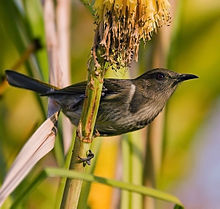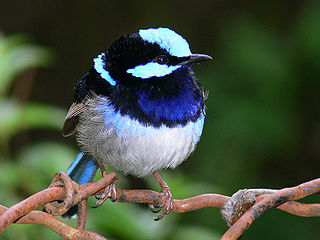
The Australasian wrens are a family, Maluridae, of small, insectivorous passerine birds endemic to Australia and New Guinea. While commonly known as wrens, they are unrelated to the true wrens. The family comprises 32 species in six genera.

The bird family Petroicidae includes 51 species in 19 genera. All are endemic to Australasia: New Guinea, Australia, New Zealand and numerous Pacific Islands as far east as Samoa. For want of an accurate common name, the family is often called the Australasian robins. Within the family species are known variously as robins, scrub-robins and flyrobins. They are only distantly related to the European robin of Europe, north Africa and western Asia, a member of family Muscicapidae.

The blue-faced honeyeater, also colloquially known as the Bananabird, is a passerine bird of the honeyeater family, Meliphagidae. It is the only member of its genus, and it is most closely related to honeyeaters of the genus Melithreptus. Three subspecies are recognised. At around 29.5 cm (11.6 in) in length, the blue-faced species is large for a honeyeater. Its plumage is distinctive, with olive upperparts, white underparts, and a black head and throat with white nape and cheeks. Males and females are similar in external appearance. Adults have a blue area of bare skin on each side of the face readily distinguishing them from juveniles, which have yellow or green patches of bare skin.

The stitchbird or hihi is a honeyeater-like bird endemic to the North Island and adjacent offshore islands of New Zealand. Its evolutionary relationships have long puzzled ornithologists, but it is now classed as the only member of its own family, the Notiomystidae. It is rare, being extirpated everywhere except Little Barrier Island, but has been reintroduced to two other island sanctuaries and four locations on the North Island mainland. Current population estimations for mature individuals in the wild are 2,500–3,400.

Meliphagoidea is a superfamily of passerine birds. They contain a vast diversity of small to mid-sized songbirds widespread in the Austropacific region. The Australian Continent has the largest richness in genera and species.

Spinebill is the name given to two members of the honeyeater family, both in the genus Acanthorhynchus, which is Latin for "spine bill". They are around 15 centimetres in length, and are coloured black, white and chestnut, with a long, downcurved bill. They are native to Australia, with one species in the east and one in the west. They feed on nectar as well as insects, and live mainly in forests, gardens, and other shrubbery habitats.

The noisy friarbird is a passerine bird of the honeyeater family Meliphagidae native to southern New Guinea and eastern Australia. It is one of several species known as friarbirds whose heads are bare of feathers. It is brown-grey in colour, with a prominent knob on its bare black-skinned head. It feeds on insects and nectar.

The white-naped honeyeater is a passerine bird of the honeyeater family Meliphagidae native to eastern Australia. Birds from southwestern Australia have been shown to be a distinct species, Gilbert's honeyeater, and the eastern birds are more closely related to the black-headed honeyeater of Tasmania. One of several similar species of black-headed honeyeaters in the genus Melithreptus, it dwells in dry sclerophyll eucalypt woodland. Its diet consists of nectar from various flowers, and it also feeds on insects.
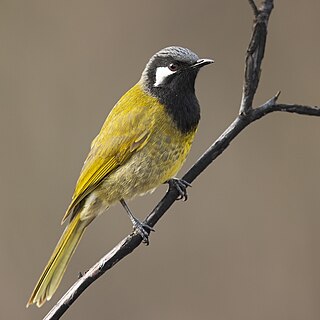
The white-eared honeyeater is a medium-sized honeyeater found in Australia. It is a member of the family Meliphagidae which has 190 recognised species with about half of them found in Australia. This makes them members of the most diverse family of birds in Australia. White-eared honeyeaters are easily identifiable by their olive-green body, black head and white ear-patch.

The black honeyeater is a species of bird in the honeyeater family Meliphagidae. The black honeyeater exhibits sexual dimorphism, with the male being black and white while the female is a speckled grey-brown; immature birds look like the female. The species is endemic to Australia, and ranges widely across the arid areas of the continent, through open woodland and shrubland, particularly in areas where the emu bush and related species occur.
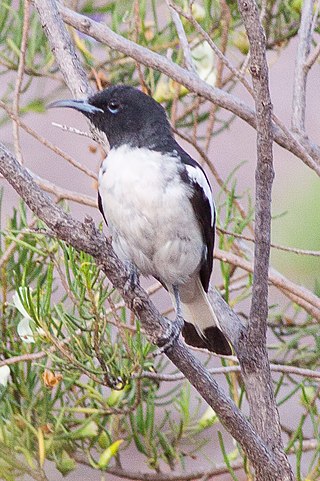
The pied honeyeater is a species of bird in the family of honeyeaters Meliphagidae and the sole species in the genus Certhionyx. This species is also known as the black and white honeyeater or western pied honeyeater.

The bristlebirds are a family of passerine birds, Dasyornithidae. There are three species in one genus, Dasyornis. The family is endemic to the south-east coast and south-west corner of Australia. The genus Dasyornis was sometimes placed in the Acanthizidae or, as a subfamily, Dasyornithinae, along with the Acanthizinae and Pardalotinae, within an expanded Pardalotidae, before being elevated to full family level by Christidis & Boles (2008).

The tawny-crowned honeyeater is a passerine bird native to southern Australia.

The crescent honeyeater is a passerine bird of the honeyeater family Meliphagidae native to southeastern Australia. A member of the genus Phylidonyris, it is most closely related to the common New Holland honeyeater and the white-cheeked honeyeater. Two subspecies are recognized, with P. p. halmaturinus restricted in range to Kangaroo Island and the Mount Lofty Ranges in South Australia.

The black-headed honeyeater is a species of bird in the family Meliphagidae. It is one of two members of the genus Melithreptus endemic to Tasmania. Its natural habitats are temperate forest and Mediterranean-type shrubby vegetation. Despite its name, the black-headed honeyeater eats predominantly insects.

The strong-billed honeyeater is a species of bird in the family Meliphagidae. It is one of two species of the genus Melithreptus endemic to Tasmania. Its natural habitat is temperate forest.

The red-headed myzomela or red-headed honeyeater is a passerine bird of the honeyeater family Meliphagidae found in Australia, Indonesia, and Papua New Guinea. It was described by John Gould in 1840. Two subspecies are recognised, with the nominate race M. e. erythrocephala distributed around the tropical coastline of Australia, and M. e. infuscata in New Guinea. Though widely distributed, the species is not abundant within this range. While the IUCN lists the Australian population of M. e. infuscata as being near threatened, as a whole the widespread range means that its conservation is of least concern.
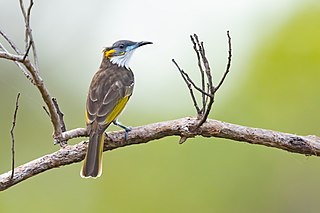
The white-streaked honeyeater is a species of bird in the family Meliphagidae. It is monotypic within the genus Trichodere. It is endemic to Cape York Peninsula in Queensland, Australia. Its natural habitat is subtropical or tropical dry forest.
Campbell's fairywren is a species of bird in the Australasian wren family, Maluridae. It is found in New Guinea. It is found in south-central and south-eastern New Guinea in its natural habitat of subtropical or tropical moist lowland forests.

Gilbert's honeyeater, also known as the Swan River honeyeater or western white-naped honeyeater, is a passerine bird of the honeyeater family Meliphagidae native to southwestern Australia. A mid-sized honeyeater, it is olive-green above and white below, with a black head, nape and throat and a white patch over the eye and a white crescent-shaped patch on the nape. The bill is brownish-black and the eyes a dull red. The sexes have similar plumage.
